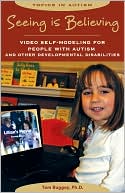List Books » Seeing Is Believing: Video Self-Modeling for People with Autism and Other Developmental Disabilities
Category Books
- Fiction Books & Literature
- Graphic Novels
- Horror
- Mystery & Crime
- Poetry
- Romance Books
- Science Fiction & Fantasy
- Thrillers
- Westerns
- Ages 0-2
- Ages 3-5
- Ages 6-8
- Ages 9-12
- Teens
- Children's Books
- African Americans
- Antiques & Collectibles
- Art, Architecture & Photography
- Bibles & Bible Studies
- Biography
- Business Books
- Christianity
- Computer Books & Technology Books
- Cookbooks, Food & Wine
- Crafts & Hobbies Books
- Education & Teaching
- Engineering
- Entertainment
- Foreign Languages
- Game Books
- Gay & Lesbian
- Health Books, Diet & Fitness Books
- History
- Home & Garden
- Humor Books
- Judaism & Judaica
- Law
- Medical Books
- New Age & Spirituality
- Nonfiction
- Parenting & Family
- Pets
- Philosophy
- Political Books & Current Events Books
- Psychology & Psychotherapy
- Reference
- Religion Books
- Science & Nature
- Self Improvement
- Sex & Relationships
- Social Sciences
- Sports & Adventure
- Study Guides & Test Prep
- Travel
- True Crime
- Weddings
- Women's Studies
Seeing Is Believing: Video Self-Modeling for People with Autism and Other Developmental Disabilities »

Authors: Tom Buggey
ISBN-13: 9781890627881, ISBN-10: 1890627887
Format: Paperback
Publisher: Woodbine House
Date Published: April 2009
Edition: (Non-applicable)
Author Biography: Tom Buggey
Tom Buggey, Ph.D., received his master's degree in special education from Clarion University of Pennsylvania and doctoral degree in early intervention from Penn State University. He conducts research at the Siskin Center for Child and Family Research at Siskin Children's Institute in Chattanooga and teaches at the University of Tennessee at Chattanooga. He and his wife, Ann, live in Hixson, Tennessee.
Book Synopsis
Video self-modeling (VSM) is a proven and effective method for teaching new or more advanced skills and behaviors to people with autism. The technique uses homemade videos (created by parents, teachers, or therapists) to demonstrate a desired behavior. The key feature of any self-modeling video is that the person modeling the behavior in the video is the same person watching the video. VSM allows a person with autism to see himself performing the very skill he is trying to learn. This is accomplished through careful editing and manipulation of video footage, transforming it into a cohesive teaching tool. And the process is a lot easier than you may think!
SEEING IS BELIEVING begins with an overview of the research and science behind VSM and insights into why it is a particularly good teaching method for people with autism and other developmental disabilities. It then explains the process of making self-modeling videos from start to finish, including how to:
choose the behavior/skill to teach
conduct a task analysis
select and use camcorders and video software
storyboard video scenes
plan and shoot footage
transfer the video to a VCR, DVD, or computer
edit and manipulate the footage
keep track of and interpret data
These videos can teach or modify a wide variety of behaviors and skills, such as controlling tantrums, increasing the frequency and length of verbal responses, making requests, interacting with peers, and solving math problems. SEEING IS BELIEVING is a good companion book to FUNCTIONAL BEHAVIOR ASSESSMENT FOR PEOPLE WITH AUTISM and STOP THAT SEEMINGLY SENSELESS BEHAVIOR!
For further information on VSM, visit siskinvsm.org whereyou will find a blog-operational in March 2009-that provides additional advice and consultation via email on VSM methods, sample videos, FAQs, and a discussion forum with professionals in the field.
CAPHIS Consumer Connections
CAPHIS Consumer Connections
Any library that includes resources for working with children with developmental disabilities should consider adding this to their collection.
Table of Contents
Introduction vii
Chapter 1 The Science Behind Self-Modeling 1
Chapter 2 The Process: From Buying Equipment to Watching the Completed Video 37
Chapter 3 Evaluating Your Results 79
Chapter 4 Real-Life Applications of Self-Modeling 89
Chapter 5 Frequently Asked Questions 107
References 117
Glossary 123
Index 127
Subjects
 Telecommunications
Telecommunications  Video Technology
Video TechnologyEntertainment
 Magazines & Newspapers Books
Magazines & Newspapers Books  Video - Direction & Production
Video - Direction & ProductionEntertainment
 Television
Television  Television - Production & Professional
Television - Production & ProfessionalEntertainment
 Video
Video  Video recording
Video recordingNonfiction
 Psychology
Psychology  Clinical Psychology
Clinical PsychologyNonfiction
 Psychology
Psychology  Psychological Disorders
Psychological DisordersNonfiction
 Psychology
Psychology  Psychology - Theory, History & Research
Psychology - Theory, History & ResearchParenting & Family
 Family - Assorted Topics
Family - Assorted Topics  Child Rearing & Development
Child Rearing & DevelopmentPsychology & Psychotherapy
 Clinical Psychology
Clinical Psychology  Methodology - Psychology
Methodology - PsychologyPsychology & Psychotherapy
 Clinical Psychology
Clinical Psychology  Psychotherapy
PsychotherapyPsychology & Psychotherapy
 Psychological Disorders
Psychological Disorders  Methodology - Psychology
Methodology - PsychologyPsychology & Psychotherapy
 Psychological Disorders
Psychological Disorders  Psychotherapy
PsychotherapyPsychology & Psychotherapy
 Psychology - Theory, History & Research
Psychology - Theory, History & Research  Behavioral Psychology
Behavioral PsychologyPsychology & Psychotherapy
 Psychology - Theory, History & Research
Psychology - Theory, History & Research  Personality & Identity Psychology
Personality & Identity PsychologyPsychology & Psychotherapy
 Psychology - Theory, History & Research
Psychology - Theory, History & Research  Testing & Assessment - Psychology
Testing & Assessment - PsychologyMedical Books
 Psychology & Psychotherapy
Psychology & Psychotherapy  Clinical Psychology
Clinical PsychologyMedical Books
 Psychology & Psychotherapy
Psychology & Psychotherapy  Psychological Disorders
Psychological DisordersMedical Books
 Psychology & Psychotherapy
Psychology & Psychotherapy  Psychology - Theory, History & Research
Psychology - Theory, History & ResearchNonfiction
 Entertainment
Entertainment  Magazines & Newspapers Books
Magazines & Newspapers BooksNonfiction
 Entertainment
Entertainment  Television
TelevisionNonfiction
 Entertainment
Entertainment  Video
Video
